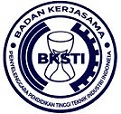Faktor yang Mempengaruhi UMKM Dalam Mengadopsi Komputasi Awan Di Kota Bandung
Abstract
Pemberdayaan internet setelah pandemi meningkat hingga 30–40%, sehingga para pelaku bisnis dituntut untuk menggunakan layanan-layanan berbasis internet seperti layanan komputasi awan agar dapat bersaing. Salah satu pelaku bisnis yang dituntut melakukan modernisasi bisnis yaitu Usaha Mikro, Kecil dan Menengah (UMKM). Imigrasi modernisasi bisnis menggunakan internet yaitu penggunaan teknologi komputasi awan adalah salah satu solusi agar UMKM dapat berkembang dan dapat bersaing dengan menerapkan platform produktivitas bisnis berbasis TIK. Penelitian sebelumnya dilakukan di Kota DIY Jogjakarta dan belum pernah dilakukan penelitian terkait faktor yang mempengaruhi UMKM dalam mengadopsi komputasi awan sehingga dapat bersaing di masa yang akan datang. Untuk memprediksi faktor-faktor yang mempengaruhi UMKM di Kota Bandung dalam mengadopsi teknologi komputasi awan dapat menggunakan metode eksploratori kuantitatif yang berbasis data berdasarkan analisis statistik yaitu SEM-PLS yang menggabungkan kerangka TOE dan kerangka TRI. Hasil dari penelitian ini didapatkan bahwa variabel complexity dan optimism memberikan pengaruh signifikan secara positif terhadap adopsi komputasi awan di Kota Bandung.
Kata kunci: UMKM, Komputasi Awan, Kerangka TOE, Kerangka TRI, SEM-PLS
Full Text:
PDFReferences
R. Ferdiana, Solusi Cloud Computing dengan Microsoft Azure Bagi UMKM. Jakarta: PT Elex Media Komputindo, 2016.
Undang-Undang Republik Indonesia Nomor 20 Tahun, “Undang-Undang Republik Indonesia Nomor 20 Tahun 2008,” no. 1, 2008.
M. G. Ayu, “Menparekraf Sebut Teknologi Cloud Menjadi Teknologi yang Paling Dibutuhkan UMKM,” 2021. https://www.cloudcomputing.id/berita/menparekraf-sebut-teknologi-cloud-dibutuhkan-umkm (accessed Nov. 26, 2022).
A. Nurannisa and G. Wibisono, “FAKTOR-FAKTOR YANG MEMPENGARUHI PENERIMAAN TEKNOLOGI KOMPUTASI AWAN (CLOUD COMPUTING) PADA USAHA MIKRO, KECIL, DAN MENENGAH (UMKM) (Studi di UMKM Propinsi Daerah Istimewa Yogyakarta),” 2014. [Online]. Available: https://repository.ugm.ac.id/id/eprint/133992
J. F. Hair, R. E. Anderson, R. L. Tatham, and W. C. Black, Multivariate Data Analysis, Multivariate Data Analysis, 8th ed., vol. 87, no. 4. Hampshire: Cengage Learning EMEA, 2019.
J. Hurwitz and D. Kirsch, Cloud Computing for Dummies 2nd Edition, 2nd Editio. Hoboken: John Wiley & Sons, 2020.
A. Khayer, N. Jahan, M. N. Hossain, and M. Y. Hossain, “The adoption of cloud computing in small and medium enterprises: a developing country perspective,” VINE J. Inf. Knowl. Manag. Syst., vol. 51, no. 1, pp. 64–91, 2019, doi: 10.1108/VJIKMS-05-2019-0064.
Y. K. Dwivedi, M. R. Wade, and S. L. Schneberger, Information Systems Theory Explaining and Predicting Our Digital Society, Vol 2. New York, 2012.
A. Parasuraman and C. L. Colby, “An Updated and Streamlined Technology Readiness Index: TRI 2.0,” J. Serv. Res., vol. 18, no. 1, pp. 59–74, 2015, doi: 10.1177/1094670514539730.
R. P. Sari, D. T. Santoso, and D. Puspita, “Analisis Kesiapan Umkm Kabupaten Karawang Terhadap Adopsi Cloud Computing Dalam Konteks Industri 4.0,” J. Tek. Ind., vol. 15, no. 2, p. 63, 2020.
Y. A. M. Qasem et al., “A multi-analytical approach to predict the determinants of cloud computing adoption in higher education institutions,” Appl. Sci., vol. 10, no. 14, 2020, doi: 10.3390/app10144905.
H. Sallehudin, R. Che Razak, M. Ismail, A. F. Md Fadzil, and R. Baker, “Cloud Computing Implementation in The Public Sector: Factors and Impact,” Asia-Pacific J. Inf. Technol. Multimed., vol. 07, no. 02(02), pp. 27–42, 2018, doi: 10.17576/apjitm-2018-0702(02)-03.
T. Oliveira, M. Thomas, and M. Espadanal, “Assessing the determinants of cloud computing adoption: An analysis of the manufacturing and services sectors,” Inf. Manag., vol. 51, no. 5, pp. 497–510, 2014, doi: 10.1016/j.im.2014.03.006.
Sugiyono, Metode Penelitian Kuantitatif, Kualitatif, dan R&D, vol. 1, no. 69. Bandung: Alabeta Bandung, 2013.
A. Nuriska, S. Asakdiyah, and R. R. Setyawan, “Factors Affecting Behavioral Intention in Using Go-Pay With the Modified Unified Theory of Acceptance and Use of Technology 2 Model (Utaut2),” Muhammadiyah Int. J. Econ. Bus., vol. 1, no. 2, pp. 107–114, 2018, doi: 10.23917/mijeb.v1i2.9366.
J. Hair, T. Hult, C. Ringle, and M. Sarstedt, A primer on partial least squares structural equation modeling (PLS-SEM), vol. 38, no. 2. Los Angeles: SAGE, 2017. doi: 10.1080/1743727x.2015.1005806.
O. Harfoushi, A. H. Akhorshaideh, N. Aqqad, M. Al Janini, and R. Obiedat, “Factors Affecting the Intention of Adopting Cloud Computing in Jordanian Hospitals,” Commun. Netw., vol. 08, no. 02, pp. 88–101, 2016, doi: 10.4236/cn.2016.82010.
DOI: http://dx.doi.org/10.24014/jti.v8i2.20037
Refbacks
- There are currently no refbacks.
Copyright (c) 2022 Ratna Puspitaningsih, Keyrien Liana, Lauditta Irianti

This work is licensed under a Creative Commons Attribution-NonCommercial-ShareAlike 4.0 International License.
Jurnal Teknik Industri
P-ISSN 2460-898X | E-ISSN 2714-6235
Published by:
Industrial Engineering Department
Universitas Islam Negeri Sultan Syarif Kasim Riau, Indonesia
Office Address:
H.R. Soebrantas KM 15.5, Tampan, Pekanbaru, Riau, Indonesia 28293
email: jti.fst@uin-suska.ac.id
Indexed by:
JTI : Jurnal Teknik Industri under a Creative Commons Attribution-NonCommercial-ShareAlike 4.0 International License.

















